Miniatures review
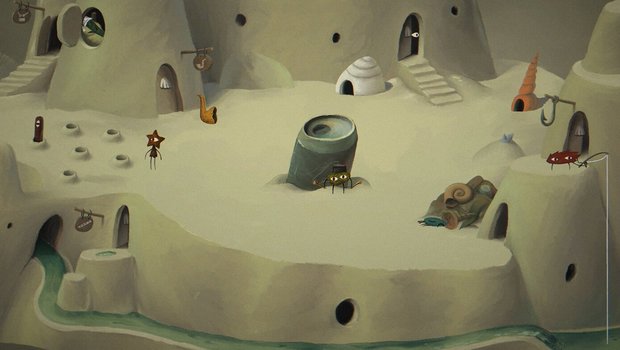
- 0 Comments
Packs big emotional punch into a short, artistically conceptual anthology series of childhood reflection
Do you know those books for children that are designed to provide a tactile, interactive experience? You can pull or slide a tab to reveal a new scene or open a little paper door to peek into a hand-drawn house. Each turn of the page reveals a new illustration or a continuation of the page before. That’s what Miniatures feels like. It aims to capture childhood memories, and it simulates flipping through an interactive storybook, albeit a darker one than those I remember. It’s like a storybook for adults looking back on their youth, and does a great job of replicating that tactile experience while presenting a beautiful and poignant series of reflections.
At the beginning of this largely isometric game, you flip a switch to turn on a light, and then turn a key to open a wooden box painted in shades of blue with a summery oceanic theme. Four items lie within: a green lizard, a red screwdriver, an ivory shell, and a brown moth. You can choose whichever item you want to start with, but I recommend going through them in the order I listed. While Miniatures doesn’t have a distinct narrative thread, the lizard is a good introduction, and the moth is all about finding closure.
I also recommend playing with headphones and completing all four miniatures in one sitting, because it’s a short game that requires your full attention. It only took me about 45 minutes to get through them all, and with headphones on it made for a meditative experience. There’s not much of a case to be made for replayability here, but I have a feeling I’ll be revisiting Miniatures in the future, much like I’d revisit a favorite short film or art installation.
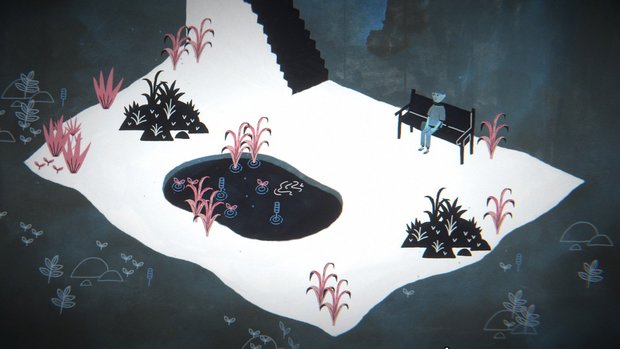
You’ll progress through four childhood memories of summer, but they’re not happy ones. Their initial mundanity belies a sadness lurking beneath, which you’ll uncover by peeling back their layers through simple point-and-click mechanics. Like I mentioned, it’s more of a tactile experience involving revealing new scenes than a series of brain-bending puzzles. You’re mostly just interacting with objects to progress, but there is a trick to some of the interactions, such as keeping tools steady while building a cabinet or pushing back against an unknown force.
Picking up the lizard will transport you into a vignette called “The Paludarium,” about a young boy named Emil who’s alone in his house, remembering a time when his father helped him build a home – a paludarium – for his pet reptile. Objects you can interact with are shaded in black, and you can click on them to progress the narrative, sometimes bringing up a first-person close-up to interact with further. The painterly art style is beautiful and illustrative, saturated in blues, giving it a gloomy atmosphere. I keep comparing Miniatures to a storybook, and that’s exactly what it looks like, but be aware that this is not a game for kids. As Emil meanders through his home, his happy memory of his father morphs into the reality of his current situation, which is anything but happy. There’s a sense of foreboding throughout, reflected in the dark shadowy corners of the house, that crescendos to an unsettling ending.
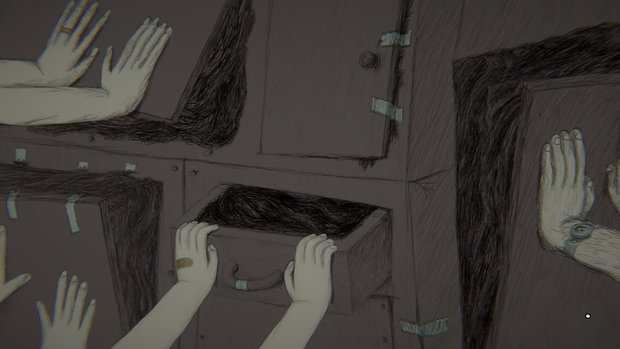
The screwdriver recounts a story of a family attempting to assemble a flat-pack cabinet together, called “Familiar.” Its art style reminds me more of a sketchbook than a storybook, like someone loosely recapturing the day’s events through their pencil. We never see the characters’ faces. Instead we’re only shown their arms and hands as they build the cabinet. It’s the most tactile of the bunch, as you’ll go through the motions of furniture construction, a seemingly normal family activity, until it becomes too much for them and the task begins to fall apart. To say that this story has elements of horror is not an understatement.
With the shell, you’ll reunite a group of estranged musicians in “The Last Sand Castle.” This vignette has a claymation appearance and comes closest to having actual puzzles. You’ll click around on various objects within the sand castle, trying to find the right sequence to help the tiny musicians recover their instruments and band together to play them. I won’t spoil the ending, but just like the other stories, it’s not as cute and childlike as it seems at first glance.
Finally, the moth has you following a young girl named Alma as she sets forth to find her mother in a mysterious seascape. It’s called “The House of the Moon,” and it’s the most like a storybook in both appearance and mechanics. You’ll use the mouse to slide the screen from panel to panel, like turning pages. The story is told completely in words, unlike the other vignettes which have more environmental storytelling. The poetic narrative that unfolds here is eerie and melancholy. It has a sense of finality, like turning the last page, making it the perfect ending to your explorations within the box.
I would be remiss if I didn’t mention the music and sound design in Miniatures, as they’re integral to the experience and worthy of headphones. Each vignette is accompanied by a unique score that fits the theme and atmosphere. “The Paludarium” has an ambient soundscape, a looping haunting piece that serves as a backdrop for its sound effects. Some of the objects you can interact with make distinct sounds, like the piano and the TV. It’s also the only segment with voice acting, from Emil and his dad. It’s sparse but well-executed.
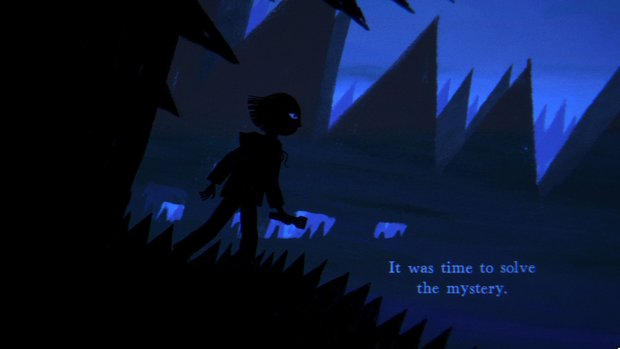
“Familiar” has musical stings and sections where the music fittingly sounds like it belongs in a horror film. The parents grunt as they point out instructions to their kids, and the kids giggle as they play while working. The tension between the family members is perfectly complemented by the music. Throughout most of the scene you’ll hear birds chirping in the background, but as the story builds to its sinister ending, the birds are silenced in favor of the dissonant accompaniment.
The music and effects in “The Last Sand Castle” mostly center around the jaunty little band and the natural environment. Waves lap and crash on the beach, the musicians play their instruments, and noises come from the items you interact with along the way. That’s really all there is to it, but it’s all that’s needed in this simple yet charming vignette – with, of course, its own dark undercurrent.
“The House of the Moon” features beautiful strings that react to the story beats as you progress. There are sound effects when interacting with pieces of the environment as well, but the music is the star of this story. It’s lovely, and I could easily see myself listening to the track on my own time. In fact, I might just do that, as Miniatures has a 10-song soundtrack available on Steam, composed by Gianfranco Dbeis.
Don’t go into these stories expecting everything to be neatly tied in a bow by the end. Each vignette is left up to interpretation, and as you slowly crack them open, you’re left with a jumble of feelings rather than a straightforward plot. It might give the impression of an art film, or perhaps a reel you’d see playing as part of a museum exhibition. For that reason, it won’t be for everyone, but it left me flooded with emotion. I felt a bit sad and solemn, but I also felt nostalgic and comforted. We tend to look at the past with rose-colored glasses, to only remember the good aspects of, for example, a childhood summer. Miniatures turns that idea on its head, suggesting that some memories are treated as keepsakes for their bright spots even when there is darkness lurking just below the surface. Some may seriously consider whether 45 minutes of a mostly conceptual experience is worth the price. For me, it absolutely is.
Final Verdict
Miniatures defies explanation in many ways. It’s meant to be interpreted through environmental storytelling and ambience, and each person might come away from it with different thoughts and ideas about what they just experienced. While not overtly scary, the dark and moody undertones make it a notable experience for horror fans as well. Those who prefer challenging puzzles and straightforward plots with tidy endings might want to skip this one, but if you’re open to a more abstract experience involving memory and nostalgia, then it’s well worth giving a chance.
Hot take
Like a beloved storybook, Miniatures is a sentimental journey through four melancholy childhood memories that will stick with you long after the final page is turned.
Pros
- Beautifully illustrated with various art styles
- Thoughtful writing with emotional depth
- Atmospheric environmental storytelling
- Excellent sound design and music complement the different emotional elements
Cons
- Conceptual themes may not resonate with everyone
- Very short at only around 45 minutes of playtime
Alyssa played Miniatures on PC using a review code provided by the game's publisher.


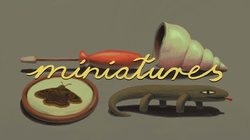








0 Comments
Want to join the discussion? Leave a comment as guest, sign in or register in our forums.
Leave a comment